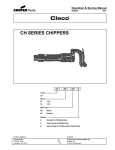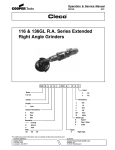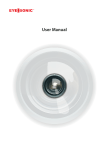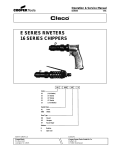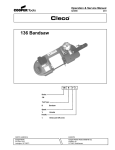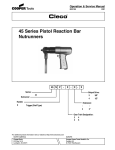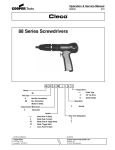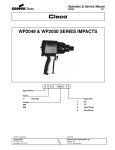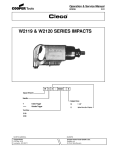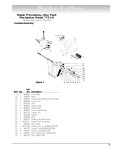Download warning - Apex Power Tools
Transcript
Operation & Service Manual 823140 2/00 R1B SERIES RAMMERS R1 B - XX Series: R1 Type: B Bench Terminations: P1 B1 Pein for R0B, R1B & R1F Models Only Butt Polyurethane 2 3/8 for R0B, R1B & R1F Models Only B2 M1 Butt Polyurethane 3 3/8 for R0B, R1B & R1F Models Only Butt Malleable Iron 2 3/8 for R0B, R1B & R1F Models Only NORTH AMERICA EUROPE CooperTools P.O. Box 1410 Lexington, SC 29071 Cooper Power Tools GmbH & Co. Postfach 30 D-73461 Westhausen 1 Safety Recommendations For your safety and the safety of others, read and understand the safety recommendations before operating any percussion tool. Always wear protective equipment and clothing. ! WARNING Impact resistant eye protection must be worn while operating or working near this tool. to endanger adjacent personnel, clear the air hose of accumulated dust and moisture. Attachment of a quick-disconnect air coupling directly to the inlet threads of a percussion tool can cause wear and failure of the coupling. Should the coupling fail, severe injury can result from the hose end violently whipping about. If a quick-disconnect air coupling is used, separate the coupling from the tool with a whip hose (1.5 feet minimum). Only use a whip hose with fittings of hardened steel or other material which is at least comparably resistant to shock. Do not use hose to lift or lower tool. For additional information on eye protection, refer to Federal OSHA Regulations, 29 CFR, Section 1910.133, Eye and Face Protection, and ANSI Z87.1, Occupational and Educational Eye and Face Protection. This standard is available from the American National Standards Institute, Inc., 11 West 42nd, New York, NY 10036. ! Coupling Nipple Quick Disconnect Coupling Do not use! Coupling Nipple CAUTION Whip Hose Personal hearing protection is recommended when operating or working near this tool. Hearing protection is recommended in high noise areas (above 85 dBA). Close proximity of additional tools, reflective surfaces, process noises, and resonant structures can substantially contribute to the sound level experienced by the operator. For additional information on hearing protection, refer to Federal OSHA Regulations, 29 CFR, Section 1910.95, Occupational Noise Exposure, and American National Standards Institute, ANSI S12.6, Hearing Protectors. Gloves and other protective clothing should be worn as required. Properly fitted gloves cushion vibration and protect the fingers from pinching, scuffing and scraping. ! Quick Disconnect Coupling OK ! WARNING Visually inspect the rammer butt or pein for damage. Discard any butt or pein that show any damage such as cracking or splitting. ! WARNING Explosive Hazard. Do not use this tool in an explosive or flammable environment. WARNING ! Compressed air hazard. Compressed air can cause loss of eyesight, bleeding or injection of foreign material into the body or blood. Never use compressed air to clean off clothing or direct it at any person. Cleco percussion tools are designed to operate on 90 psig (6.2 bar) maximum air pressure. Excessive air pressure can damage the plunger and increases sound levels. Installation of a filter-regulator-lubricator in the air supply line ahead of the tool is highly recommended. Before the tool is connected to the air supply, check the throttle for proper operation (i.e., throttle moves freely and returns to closed position). Being careful not 2 WARNING Impact Hazard. Rammer butts and peins can cause serious injury. Disconnect air before changing butts or peins. Do not operate unless butt or pein is in contact with workpiece. Do not point tool in direction of any person. Before removing a tool from service, after completing a job, or changing chisels or other bits, make sure the air line is shut off and drained of air. This will prevent the tool from operating if the throttle is accidently engaged. Use of a self-relieving valve within reach of the user of the tool is highly recommended. Safety Recommendations BAD POSTURE INDIVIDUAL WORK STATION Self-Relieving Valve Regulator Lubricator 0 45 90 Coupling Filter Hose Quick Disconnect Coupling GOOD POSTURE Tool Do not operate or trigger any rammer unless the butt or pein is on the tool and in contact with the workpiece or worksurface. Never point any rammer in the direction of another person or yourself. Failure to do so can cause serious injury. Some individuals ! WARNING may be susceptible to disorders of the hands and arms when performing tasks consisting of Repetitive work motions and/or vibration highly repetitive momay cause injury to hands and arms. tions and/or expoUse minimum hand grip force. Keep body and hands warm and dry. sure to extended viAvoid anything that inhibits blood circulation. bration. Cumulative Avoid continuous vibration exposure. Keep wrists straight. trauma disorders Avoid repeated bending of wrists and hands. such as carpal tunnel syndrome and tendonitis can be caused or aggravated by repetitious, forceful exertions of the hands and arms. Vibration may contribute to a condition called Raynaud’s Syndrome. These disorders develop gradually over periods of weeks, months, and years. It is presently unknown to what extent exposure to vibrations or repetitive motions may contribute to the disorders. Hereditary factors, vasculatory or circulatory problems, exposure to cold and dampness, diet, smoking and work practices are thought to contribute to the conditions. Any user suffering prolonged symptoms of tingling, numbness, blanching of fingers, clumsiness or weakened grip, nocturnal pain in the hand, or any other disorder of the shoulders, arms, wrists, or fingers is advised to consult a physician. If it is determined that the symptoms are job related or aggravated by movements and postures dictated by the job design, it may be necessary for the employer to take steps to prevent further occurrences. These steps might include, but are not limited to, repositioning the workpiece or redesigning the workstation, reassigning workers to other jobs, rotating jobs, changing work pace, and/or changing the type of tool used so as to minimize stress on the operator. Some tasks may require more than one type of tool to obtain the optimum operator/tool/task relationship. • Tasks should be performed in such a manner that the wrists are maintained in a neutral position, which is not flexed, hyperextended, or turned side to side. • Stressful postures should be avoided. Select a tool appropriate for the job and work location. Work gloves with vibration reducing liners and wrist supports are available from some manufacturers of industrial work gloves. Tool wraps and grips are also available from a number of different manufacturers. These gloves, wraps, and wrist supports are designed to reduce and moderate the effects of extended vibration exposure and repetitive wrist trauma. Since they vary widely in design, material, thickness, vibration reduction, and wrist support qualities, it is recommended that the glove, tool wrap, or wrist support manufacturer be consulted for items designed for your specific application. Proper fit of gloves is important. Improperly fitted gloves may restrict blood flow to the fingers and can substantially reduce grip strength. This information is a compilation of general safety practices obtained from various sources available at the date of production. However, our company does not represent that every acceptable safety practice is considered herein, or that abnormal or unusual circumstances may not warrant or require additional procedures. Your work may require additional specific safety procedures. Follow these procedures as required by your company. For more information, see the latest edition of ANSI B186.1, Safety Code for Portable Air Tools, available from the American National Standards Institute, Inc., 11 West 42nd, New York, NY 10036. 3 ! Eye protection must be worn when disassembling tool or when air line WARNING is turned on. A self-relieving valve in close proximity to the repair station to bleed off air is recommended. OPERATING INSTRUCTIONS The CLECO R1B Bench Rammer is designed to operate on 90 psig air pressure using a 5/16" I.D. hose up to 8' in length. If additional length is required, a 3/8" I.D. or larger hose should be connected to the 5/16" hose. use a heavy oil, as this will cause a loss of efficiency. If the operation of the scaler becomes sluggish or erratic, pour one teaspoon of kerosene into the air inlet and operate the tool for a few The air hose should be cleared of accumulated seconds. Lubricate the tool as explained above dirt and moisture, then one-half (1/2) teaspoon after flushing. of 10W machine oil should be poured into the tool's air inlet before connecting the hose to the STORAGE tool. In the event that it becomes necessary to store Important: The handle should be checked af- the tool for an extended period of time (overter the first eight hours of operation and occa- night, weekend, etc.), it should receive a gensionally thereafter to make sure it is tight. erous almount of lubrication at that time and again when returned to service. Store the tool LUBRICATION in a clean and dry environment. Alternatively, tools may be put in a bucket of kerosene or light An automatic in-line filter-regulator-lubricator is oil for extended periods of storage such as recommended as it increases tool life and keeps weekends or plant shutdowns. The tool should the tool in sustained operation. The in-line lubri- always be lubricated before storage and when cator should be regularly checked and filled being returned to service. with a good grade of 10W machine oil. Never 4 ! Eye protection must be worn when disassembling tool or when air line WARNING is turned on. A self-relieving valve in close proximity to the repair station to bleed off air is recommended. SERVICE INSTRUCTIONS DISASSEMBLY To disassemble the tool remove the butt from the piston rod. Turn lock nut, No. 832853, toward the backhead end of the barrel until locking key, No. 832233, has disengaged the packing gland nut, No. 832877. The packing gland nut may be removed by turning it in a counter-clockwise direction which will permit the removal of the packing gland nut seal, No. 832928. The packing assembly consisting of packing, No. 831284, packing washer, No. 832893, and packing gland may be removed from the barrel by pulling the piston toward the packing end. As the piston comes out of the barrel the packing assembly will be pulled out ahead of it. allow throttle valve spring, No. 843250, and throttle valve, No. 844069, to drop out. If the throttle valve leaks, it should be replaced. If it should be necessary to replace throttle valve casing, No. 832061, the throttle valve will have to be reseated to the new casing. This may be done by dropping the throttle valve against the seat and tapping it with a brass rod to form a good seat. Place the flats of the barrel in a vise with backhead, No. 832815, upward and remove locking collar, No. 832831. This will allow the removal of the backhead from the barrel. After the backhead has been removed, place the piston back in the barrel and push it toward the valve end of the barrel to drive out the valve assembly consisting of valve block, No. 832504, valve, No. 832194, and valve block cap, No. 833247. The valve assembly must be separated to inspect the valve. REASSEMBLY The tool is reassembled in the reverse order in which it was disassembled. Wash all parts thoroughly in kerosene before reassembling. Be sure that all air passages in the barrel and valve assembly are free of any dirt or foreign matter. The packing gland nut seal, No. 832928, is installed in the packing gland nut with the lip or slot toward the butt. When reassembling the packing, tighten the packing gland nut down until a drag is felt on the piston rod when the piston is moved up and down in the barrel. After reassembly, place a few drops of 10W machine oil in inlet bushing, No. 841553, before attaching the air hose. This will insure immediate lubrication of all parts as soon as the air is applied. If the barrel has been honed to accept an oversize piston, it is imperative that the corresponding oversize valve block be used. The valve block must be a press fit in the barrel to ensure correct operation of the tool. The backhead should be checked after the first eight hours of operation and occasionally thereafter to make sure it is tight. If the internal parts of the tool show a lack of lubrication and the oil reservoir is still full of oil, it is evident that oilite bushing, No. 833590, has become clogged with dirt. The bushing should be drilled out and a new bushing inserted. Before inserting the new oilite bushing, place the oil reservoir under light air pressure. If the air does not blow through the small hole in oil reservoir plate, No. 833262, the hole should be cleaned out with a small rod. To disassemble the throttle valve, remove throttle valve casing cap, No. 832644, and Remove inlet bushing, No. 841553, and wash in kerosene. Blow air through it in reverse of normal air flow to remove any foreign matter that may be lodged in the screen. If the screen is torn or damaged, inlet bushing, No. 841553, should be replaced. 5 R1B BENCH RAMMER 829557- 1" x 2 5/8" Pein - Polyurethane 829558- 2 3/8" Butt - Polyurethane 829559- 3 3/8" Butt - Polyurethane 832925- 2 3/8" Butt - Malleable Iron 832877 832928 831284 832869 832853 832233 832893 832266 832720 832831-2 832504 832740 832194 833247 832125 832644 843250 843021 844069 832815 832061 831312 841553 833816 843430 833590 832126 832126 832154 832840 832031 6 PART LIST — R1B BENCH RAMMER PART NO. NAME OF PART 831284 832031 832061 832125 832126 832154 832194 832233 832266 832504 832644 832720 832740 832815 832831 832840 832853 832869 832877 832893 832928 833247 833262 833590 833816 841553 843021 843250 843430 844069 QTY. Packing Set Throttle Valve Pin Throttle Valve Casing Dowell Pin Throttle Valve Lever & Toggle Retainer Pin Throttle Valve Lever Valve Locking Key Barrel Valve Block Throttle Valve Cap Dowell Pin Piston Backhead Locking Collar Throttle Valve Lever Toggle Packing Gland Lock Nut Packing Gland Packing Gland Nut Rear Packing Washer Packing Gland Nut Seal Valve Block Cap Oil Reservoir Plate Oilite Bushing Gasket Inlet Bushing Oiler Felt Throttle Valve Spring Oil Plug Throttle Valve Ball 1 1 1 1 2 1 1 1 1 1 1 1 1 1 1 1 1 1 1 1 1 1 1 1 1 1 6 1 1 1 SUBASSEMBLIES 831105 — Valve Block (832125, 832194, 832504, 833247) 831228 — Backhead (831312, 832031, 832061, 832126, 832154, 832644, 831228, 832840, 833176, 841553, 843021, 843250, 843430, 844069) 831310 — Oil Reservoir Plate (833262, 833590) OPTIONAL PARTS 832925 — 2 3/8" Malleable Iron Butt 829558 — 2 3/8" Polyurethane Butt 829559 — 3 3/8" Polyurethane Butt 829557 — 1" x 2 5/8" Polyurethane Pein OVERSIZE REPLACEMENT PARTS OVERSIZE PISTON VALVE BLOCK .001" 834160 .002" 834170 .003" 834162 .004" 834172 834845 .006" 834174 834846 .008" 834176 834847 .010" 834166 833499 834844 7 CooperTools 670 Industrial Drive Lexington, SC 29072 Phone: (803) 359-1200 Fax: (803) 359-2013 www.cooperindustries.com 8








